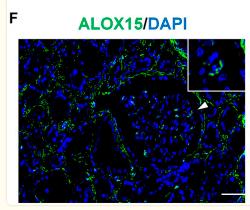15 Lipoxygenase 1 Antibody - #DF13494
| Product: | 15 Lipoxygenase 1 Antibody |
| Catalog: | DF13494 |
| Description: | Rabbit polyclonal antibody to 15 Lipoxygenase 1 |
| Application: | WB |
| Cited expt.: | |
| Reactivity: | Human, Rat |
| Prediction: | Pig, Bovine, Sheep, Rabbit, Dog |
| Mol.Wt.: | 74kDa; 75kD(Calculated). |
| Uniprot: | P16050 |
| RRID: | AB_2846513 |
Related Downloads
Protocols
Product Info
*The optimal dilutions should be determined by the end user. For optimal experimental results, antibody reuse is not recommended.
*Tips:
WB: For western blot detection of denatured protein samples. IHC: For immunohistochemical detection of paraffin sections (IHC-p) or frozen sections (IHC-f) of tissue samples. IF/ICC: For immunofluorescence detection of cell samples. ELISA(peptide): For ELISA detection of antigenic peptide.
Cite Format: Affinity Biosciences Cat# DF13494, RRID:AB_2846513.
Fold/Unfold
15 lipoxygenase 1; 15 LIPOXYGENASE RETICULOCYTE ARACHIDONATE; 15 LOX; 15 LOX 1; 15-LOX; 15LOX 1; ALOX15; Arachidonate 15 lipoxygenase; Arachidonate 15-lipoxygenase; Arachidonate omega 6 lipoxygenase; Arachidonate omega-6 lipoxygenase; LOG15; LOX15_HUMAN;
Immunogens
A synthesized peptide derived from human 15 Lipoxygenase 1, corresponding to a region within C-terminal amino acids.
Detected in monocytes and eosinophils (at protein level). Expressed in airway epithelial cells.
- P16050 LOX15_HUMAN:
- Protein BLAST With
- NCBI/
- ExPASy/
- Uniprot
MGLYRIRVSTGASLYAGSNNQVQLWLVGQHGEAALGKRLWPARGKETELKVEVPEYLGPLLFVKLRKRHLLKDDAWFCNWISVQGPGAGDEVRFPCYRWVEGNGVLSLPEGTGRTVGEDPQGLFQKHREEELEERRKLYRWGNWKDGLILNMAGAKLYDLPVDERFLEDKRVDFEVSLAKGLADLAIKDSLNVLTCWKDLDDFNRIFWCGQSKLAERVRDSWKEDALFGYQFLNGANPVVLRRSAHLPARLVFPPGMEELQAQLEKELEGGTLFEADFSLLDGIKANVILCSQQHLAAPLVMLKLQPDGKLLPMVIQLQLPRTGSPPPPLFLPTDPPMAWLLAKCWVRSSDFQLHELQSHLLRGHLMAEVIVVATMRCLPSIHPIFKLIIPHLRYTLEINVRARTGLVSDMGIFDQIMSTGGGGHVQLLKQAGAFLTYSSFCPPDDLADRGLLGVKSSFYAQDALRLWEIIYRYVEGIVSLHYKTDVAVKDDPELQTWCREITEIGLQGAQDRGFPVSLQARDQVCHFVTMCIFTCTGQHASVHLGQLDWYSWVPNAPCTMRLPPPTTKDATLETVMATLPNFHQASLQMSITWQLGRRQPVMVAVGQHEEEYFSGPEPKAVLKKFREELAALDKEIEIRNAKLDMPYEYLRPSVVENSVAI
Predictions
Score>80(red) has high confidence and is suggested to be used for WB detection. *The prediction model is mainly based on the alignment of immunogen sequences, the results are for reference only, not as the basis of quality assurance.
High(score>80) Medium(80>score>50) Low(score<50) No confidence
Research Backgrounds
Non-heme iron-containing dioxygenase that catalyzes the stereo-specific peroxidation of free and esterified polyunsaturated fatty acids generating a spectrum of bioactive lipid mediators. Converts arachidonic acid into 12-hydroperoxyeicosatetraenoic acid/12-HPETE and 15-hydroperoxyeicosatetraenoic acid/15-HPETE. Also converts linoleic acid to 13-hydroperoxyoctadecadienoic acid. May also act on (12S)-hydroperoxyeicosatetraenoic acid/(12S)-HPETE to produce hepoxilin A3. Probably plays an important role in the immune and inflammatory responses. Through the oxygenation of membrane-bound phosphatidylethanolamine in macrophages may favor clearance of apoptotic cells during inflammation by resident macrophages and prevent an autoimmune response associated with the clearance of apoptotic cells by inflammatory monocytes. In parallel, may regulate actin polymerization which is crucial for several biological processes, including macrophage function. May also regulate macrophage function through regulation of the peroxisome proliferator activated receptor signaling pathway. Finally, it is also involved in the cellular response to IL13/interleukin-13. In addition to its role in the immune and inflammatory responses, may play a role in epithelial wound healing in the cornea maybe through production of lipoxin A4. May also play a role in endoplasmic reticulum stress response and the regulation of bone mass.
Cytoplasm>Cytosol. Cell membrane>Peripheral membrane protein. Lipid droplet.
Note: Predominantly cytosolic; becomes enriched at membranes upon calcium binding. Translocates from the cytosol to the plasma membrane when stimulated by IL13/interleukin-13 and in macrophages binding apoptotic cells.
Detected in monocytes and eosinophils (at protein level). Expressed in airway epithelial cells.
The PLAT domain can bind calcium ions; this promotes association with membranes.
Belongs to the lipoxygenase family.
Research Fields
· Cellular Processes > Cell growth and death > Ferroptosis. (View pathway)
· Cellular Processes > Cell growth and death > Necroptosis. (View pathway)
· Metabolism > Lipid metabolism > Arachidonic acid metabolism.
· Metabolism > Lipid metabolism > Linoleic acid metabolism.
· Metabolism > Global and overview maps > Metabolic pathways.
· Organismal Systems > Nervous system > Serotonergic synapse.
References
Application: IF/ICC Species: Mice Sample:
Restrictive clause
Affinity Biosciences tests all products strictly. Citations are provided as a resource for additional applications that have not been validated by Affinity Biosciences. Please choose the appropriate format for each application and consult Materials and Methods sections for additional details about the use of any product in these publications.
For Research Use Only.
Not for use in diagnostic or therapeutic procedures. Not for resale. Not for distribution without written consent. Affinity Biosciences will not be held responsible for patent infringement or other violations that may occur with the use of our products. Affinity Biosciences, Affinity Biosciences Logo and all other trademarks are the property of Affinity Biosciences LTD.


